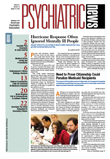Is the schizophrenia typically seen by clinicians today milder than the disease described by Emil Kraepelin in the 19th century or even that commonly seen by clinicians in the middle of the 20th?
And might natural selection be at work, progressively thinning the population of the most sorely affected patients while allowing a less-severe form of disease to survive into our day?
That's the intriguing idea floated by Thomas McGlashan, M.D., in an editorial in the July Schizophrenia Bulletin.
In an interview with Psychiatric News, McGlashan acknowledged that the notion hardly occurs to clinicians busy treating a disease no one would describe as mild. And credible research comparing the disease as it presented 100 years ago with today's malady is nonexistent.
But McGlashan suggests it may be reasonable for contemporary researchers and clinicians to look up, so to speak, from their work and ponder why it is that “recovery” is advanced as an expectable goal for many patients today, when 60 years ago such a notion would never have been considered.
He noted that the subjective experience of clinicians whose careers have spanned several decades seems to confirm that the severity of schizophrenia has ameliorated over the years.
“The question occasionally comes up with older colleagues about how many catatonic patients they've seen recently,” McGlashan said.“ And the answer is that we haven't seen any, or any of the really deteriorating cases that as a medical student I can recall seeing in the early 1960s. I can remember some of us had a trip to a state hospital then and went to the infamous building where they had the worst cases. They were really vegetative and scary, and even though they were medicated—this was in the early days of antipsychotic medication, and all of them were on Thorazine—they were often mute.”
Remembering Different Disorder
Those impressions are bolstered by writings from Kraepelin on describing a schizophrenia that might seem to be a thing of the past. In his editorial, McGlashan cites two clinicians writing in the 1970s and 1980s who remember seeing a different disease earlier in their career.
“I believe that schizophrenic illnesses today are milder and that one rarely sees patients experiencing an acute, unremitting catastrophic course,” wrote John Romano, M.D., in the Bulletin in 1977.
And in 1987 John Ellard, M.D., writing in the Australian-New Zealand Journal of Psychiatry, concluded a reminiscence about 40 years of treating schizophrenia with the remarkable comment: “Whereas then my patient and I struggled to communicate at all, now we are likely to finish up discussing the dopamine hypothesis.”
Better treatment, including release from the back wards of state hospitals, surely has contributed to the impression that patients are less severely ill. But McGlashan believes it is possible that natural selection is at work.
Is Schizophrenia Recent Phenomenon?
It is a notion that is overlooked, he said, in part because it implies that schizophrenia is a relatively recent phenomenon. That theory, and the possibility that schizophrenia may not have existed before the 17th century, has been advanced by schizophrenia researcher Fuller Torrey, M.D., in The Invisible Plague (Rutgers University Press, 2001). Moreover, most people are accustomed to thinking of natural selection as a process that occurs over many centuries, rather than over one or two.
But McGlashan believes there may be something to Torrey's theory and compelling reasons for considering natural selection as one cause for the amelioration of the disease: a very high degree of phenotypic diversity is described by Kraepelin and his forebears, and it may be that reproductive capacity varies inversely with phenotypic severity.
As he writes in the Bulletin, “If such a process were active, we would expect to see a marked reduction in the reproductive capacity of those afflicted and to see selection against the most debilitating forms of the disorder. The former has been documented many times, and the latter appears to match the longitudinal data.”
McGlashan told Psychiatric News that he is currently working with Danish researchers to look at the reproductive capacity of patients and their family members. Preliminary research confirms existing data: patients with schizophrenia from the latter decades of the 20th century produced fewer children than the general population.
The idea that schizophrenia is a relatively recent phenomenon, a genetic predisposition that has blossomed into disease in the industrial and postindustrial environment of the last two-and-a-half centuries, is more than a midsummer fancy. For it implies new avenues for thinking about pathophysiology of the disease, something McGlashan believes is long overdue.
“We need to start thinking about schizophrenia in ways other than dopamine metabolism,” he said. “That theory has generated a lot of reasonably good treatments, but it's not getting us much further. We are spending a lot of time and money trying to tweak that system, and I think we have reached a stage of diminishing returns.”

